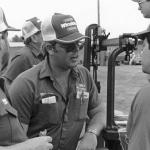In trendy NASCAR, champions aren’t topped till the final lap of the final race of the season. 4 drivers (from three tremendous groups) arrive on the season finale with one final likelihood on the title — and the best finisher wins all of it. This weekend, Ryan Blaney, Joey Logano, Tyler Reddick, and William Byron will battle to see who comes out a champion. They usually’ll go to battle at Phoenix Raceway in Avondale, Arizona.
Phoenix is arguably an important observe in NASCAR, if solely as a result of it is the place the champion’s been topped since 2020. The 1.0-mile asphalt oval is not with out its quirks and particular methods, both. That is why I known as up the winningest Cup Collection driver ever at Phoenix, Kevin Harvick, who racked up 9 victories throughout greater than twenty years.
So, how do you win Phoenix and the NASCAR Cup Collection championship, in Harvick’s thoughts?
“Effectively, that is a loaded query,” he stated.
Harvick might have lately retired from full-time driving to grow to be a commentator on races for FOX Sports activities (and host a podcast host with the community “Kevin Harvick’s Pleased Hour”), however the retired champion kindly defined, in champion-level element, precisely what it takes to depart with the trophy.
A fast Kevin Harvick historical past lesson on Phoenix Raceway
Phoenix Raceway
Picture by: David Rosenblum / NKP / Motorsport Pictures
NASCAR hosted its season finale on the 1.5-mile Homestead-Miami Speedway oval in Florida earlier than the grand finale moved to Phoenix in 2020. NASCAR has stated it doubtless gained’t keep there eternally, however hasn’t shared any concrete plans about what’s subsequent.
Phoenix is a “large half” of Harvick’s profession — from the outdated days to the fashionable ones, after the Cup Collection launched its new “NextGen” race automotive and basically flipped the observe structure.
“I grew up on the West Coast, and Phoenix was type of our Tremendous Bowl for the touring divisions all through the years,” Harvick stated. “However that Phoenix shouldn’t be the identical Phoenix we see at this time. [The track] was very uniquely redesigned to have a stadium really feel to it.
“The beginning-finish line was once on what’s now the again straightaway. The entrance straightaway was redesigned so followers may see it from the infield. You’re actually in place to see nice finishes, which we’ve got seen. And what’s now the entrance straightaway was banked so you possibly can elevate and see the automobiles from different locations on the racetrack.”
Harvick categorizes Phoenix in 3 ways: quick, flat, and “identified for its restarts.” There’s asphalt from the skin wall to pit-road exit, main automobiles to fan out six-wide on restarts. Phoenix additionally isn’t a typical oval. It has 4 turns and a front-straightaway dogleg that’s not labeled as an official nook, which is the place these restarts happen.
Phoenix hasn’t been universally cherished because the season finale — particularly with barn-burners at Homestead — as a result of quick tracks have been a wrestle with the NextGen automotive. However Phoenix has all of the glitz of a season finale on the floor, and all of the challenges of 1 beneath.
These challenges begin, in some methods, on the finish.
Harvick’s Phoenix Tip #1: Keep unfastened
Phoenix is a observe the place getting the final laps proper is perhaps extra essential than nailing the beginning.
“It is advisable qualify good, however I do not suppose that is the tip of the world. In case your automotive’s going to win, it’s essential to be good on the long term. You must have a automotive which you could regulate on all through the day. The way it begins is not how it should want to complete.”
In NASCAR, races have “lengthy runs” and “quick runs.” Cup automobiles can final 95 laps on one tank of gas, and the race itself lasts 312. A brief run at Phoenix maxes out at about 30 laps within the Cup automotive owing largely to tire degradation: the rubber breaks down intensely over the primary 30 laps earlier than plateauing and carrying way more slowly over the subsequent 70 laps or so.
“Kevin discovered pace by being quickest throughout that plateau space,” defined one race engineer I spoke with. “Since lap occasions degrade little or no throughout that part of the run, it’s all about consistency.”
However the Phoenix finale is about greater than consistency. It’s about anticipation.

William Byron and Kevin Harvick lead the cost in 2023 in Phoenix
Picture by: Matthew T. Thacker / NKP / Motorsport Pictures
The race begins noon and transitions into nightfall, so the automotive needs to be arrange for the decrease temps of a desert sundown. The observe’s floor adjustments with the warmth loss and the rubber buildup from tires, which means groups have to search out the precise steadiness between unfastened (rotates an excessive amount of, prefer it’s on ice skates) and tight (doesn’t flip sharply sufficient).
“We noticed it final yr,” stated Harvick. “We noticed the racetrack actually change. Quite a lot of the automobiles that have been tremendous unfastened to start out the race wound up being the actually good automobiles on the finish, as a result of the observe tightens up because the day goes on. I feel you simply need to run the automotive as unfastened as potential, and typically somewhat looser than you prefer it, as a way to maintain the flip within the automotive all through the entire day.”
Harvick’s Phoenix Tip #2: Grasp the restarts

A patented Phoenix restart in 2019
Picture by: Russell LaBounty / NKP / Motorsport Pictures
Phoenix restarts are one-of-a-kind. NASCAR’s rolling-start restarts convey automobiles two-wide towards the inexperienced flag. However in Phoenix, automobiles instantly dive left to drive the shortest distance potential by way of the dogleg, fanning out five- and six-wide.
There’s only one downside: the yellow line marking the “backside” of the observe, the place it transitions from banked nook to flat apron, means not everybody will get to the place they need to go.
“The toughest half concerning the restart shouldn’t be mistiming it, as a result of you may’t go beneath the yellow line till you get to the start-finish line,” Harvick stated. “The very first thing all people needs to do is go left, so from a driver’s standpoint, you simply have to concentrate on the place that start-finish line is as a way to not get a penalty.
“However you may’t be conservative. You must go as little as you may go, as a result of in case you do not, someone’s going to go decrease. We do not see a ton of wrecks, however the ones that do occur are normally from someone being gradual to react or not going all the best way to the underside. Any person shoves their nostril within them, and subsequent factor you understand, someone hits the within wall.”
A driver’s place within the area may make or break their restart in Phoenix. NASCAR restarts usually have about 40 automobiles in two traces of 20, and the lead automotive accelerates in a “restart zone” earlier than the inexperienced flag. However with the Phoenix reconfiguration, a whole lot of the sphere remains to be within the closing nook when the chief accelerates.
“Having the ability to speed up within the nook shouldn’t be straightforward,” Harvick stated.
Then, there’s the bodily toll these left-hooks take. Drivers slam onto the flatter apron from the banked racing floor, and so they don’t have comfortable suspension to guard them.
“Once I drove the NextGen automotive, the very last thing I wished to do was go on the apron,” Harvick stated. “It is probably the most uncomfortable journey you possibly can probably think about, as a result of the automotive bottoms out. It is a jarring blow each time.”
Harvick’s Phoenix Tip #3: Brake exhausting, drive tougher
Restart or not, drivers need to settle right into a rhythm round Phoenix. Which means carrying as a lot pace into and out of the corners as potential.
“The very first thing that I all the time attempt to inform folks is: You must get the braking,” stated Harvick. “I feel having the ability to nonetheless get a pleasant form into the nook, however drive the automotive into the nook as exhausting as you may, is the place we all the time made up a whole lot of time.”
Harvick additionally stated drivers “cannot be locked into one line.”
“If all people’s on the underside of the racetrack, you are by no means going to move them,” Harvick stated. “That was one factor that all the time made us good with this type of racetrack: the truth that you had to search around round for what you wanted to be doing.”
Harvick was additionally good at Phoenix as a result of “you path off the brake and go proper again to the throttle, and there was not a whole lot of out-of-the-throttle roll time.” It suited his driving type, and if he nailed the transition from brake to throttle, he knew it was an excellent lap.
“The primary cue, for me, was after I would let off the brake: what the entrance tires would do, and the way lengthy it took for these entrance tires to seize and go the opposite path,” Harvick stated. “The second cue was: How exhausting may I put the throttle down on the exit of the nook?”
As a result of Phoenix is a unique form on every finish of the observe, the approach is completely different in Turns 1 and a pair of than it’s in Turns 3 and 4. (And sometimes, Harvick stated, in case you do effectively in Turns 1 and a pair of, you’ll overdrive 3 and 4. It’s exhausting to get an ideal lap in.)
“I all the time discovered that Phoenix was a spot the place, in Flip 1, you possibly can flip the steering wheel loads tougher than most locations,” Harvick stated. “That second tug on the wheel was one thing I felt like was a bonus for us, having the ability to nonetheless have your automotive flip by way of the center of 1 and two — and as quickly because it did flip, having the ability to return to the throttle and drive up off the nook.”
In Turns 3 and 4, Harvick had his eyes on one factor: the yellow line.
“For me, Flip 3 was a nook that I wished to have the ability to drive the automotive in straight,” Harvick stated. “I wished to have my eyes in direction of the within wall to select up that yellow line, as a result of I felt prefer it was type of like a trough. The left-front tire loves that little line within the trough.
“In the event you may hit it proper together with your left-front, then you possibly can elevate off the brake and begin to apply some partial throttle. Then [you could] have your eyes up and drive straight [toward] the start-finish line. I feel you are going to win the race on the underside in 3 and 4.”










